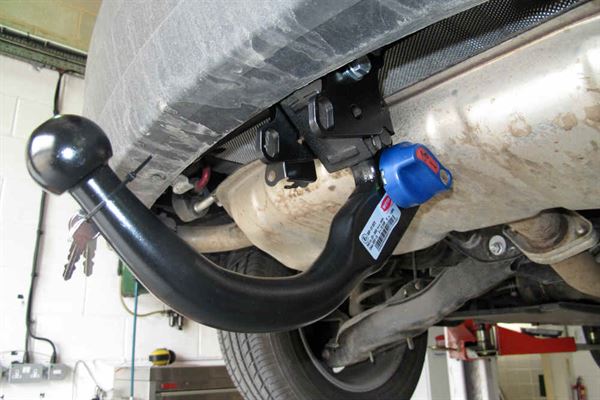A towbar is one of the most useful accessories you could install on a car. As the name suggests, it's a short attachment on the back of your vehicle. You can use it to tow trailers, caravans, and more.
Installing a towbar on your vehicle lets you tow trailers and caravans, which can be useful when you need to dispose of waste, move house, carry supplies and gear, or go cross-country driving! Also, it adds protection to your car’s rear during a collision.
In this article, you’ll discover how a towbar can benefit your vehicle and more about why you should have one installed.
Let’s get to it!
What Is the Benefit of a Towbar?
The overall benefit of having a towbar on your vehicle is that it allows you to tow cargo behind it. Adding that ability to your car might seem like a minor deal initially. However, it unlocks a long list of possible uses.
Here are some of the top ways a towbar can benefit you:
1. Waste Disposal
Firstly, a towbar can be significantly beneficial if you have a lot of waste to dispose of.
Let’s say you have just been doing some spring cleaning around your home and are now looking at a colossal pile of old furniture, junk, and more junk.
Instead of hiring a truck to haul away all that waste, you can do it yourself when you have a towbar. Then, you only need to hook up a trailer to it, load your junk, and drive it to the nearest waste disposal facility.
2. Moving Between Houses
Besides removing waste, a towbar is also very handy when moving homes. Getting furniture, appliances, and other goods from point A to point B can be expensive when you hire professional movers to do it for you.
Thankfully, a towbar can help you with that and save you from spending hard-earned money on moving things.
3. Long-Distance Travel
Towbars are also priceless additions for adventurous drivers. As you can imagine, you can tow an entire caravan with a towbar attached to your vehicle.
That opens countless possibilities for cross-country travel since you can bring your accommodation with you.
4. Carrying Supplies or Equipment
Towbars can also help you carry supplies or equipment between locations. Tradespeople can easily bring their gear wherever they go if their vehicle has a towbar.
5. Added Rear-End Protection
Most people don’t realise that a towbar also offers extra protection to the vehicle’s rear—yeah, seriously! More specifically, a towbar can absorb some of the impact during a rear-end collision and minimise damage to the rest of the car.
Of course, that’s only true if the vehicle gets hit from behind where the towbar is mounted.
Is It Safe to Use a Towbar?
Yes, using a towbar is entirely safe as long as you ensure the following:
- Legal compliance: First and foremost, you must ensure that your towbar meets all local road rules and regulations. You might think the towbar is installed correctly, but following the law ensures you don’t miss any potential safety hazards.
- Compatibility: Towbars are not a one-size-fits-all car accessory. You guessed it, you must only use one that is compatible with your particular vehicle type. So, before you buy and install a towbar, please do due diligence, and ensure that it fits well with your car.
- Correct fitting: The world's best towbar is only as good as how correctly it's installed. You should get a professional to do the job. The towbar installation cost is well worth all the effort and expense by ensuring your safety and giving you peace of mind.
- Safe Usage: While safe towbar installation is crucial, proper usage is equally important. Always read and follow the user manual to ensure you attach and detach things correctly to that towbar. After all, you don’t want your trailer to accidentally come unhitched while on the road!
- Regular inspections: Inspect your towbar regularly—include this task in your routine vehicle maintenance and have a professional check that it’s still in good shape.
Follow the points above, and you can rest assured that your towbar will serve its purpose and keep you and your cargo safe.
What Are the Types of Towbars?
There are two types of towbars: flange towbars and swan neck towbars.
The flange towbar is called that because it’s bolted onto a flange plate with 2-4 bolts. That plate is then bolted to the vehicle’s underside.
Flange towbars are considered less attractive because the bolts mentioned above are visible from afar.
That’s quite different from the second type of towbar, the swan neck towbar. As you can imagine, this towbar gets its name from its shape. It has a ‘swan neck’ shape and attaches directly to the car’s underside.
The swan neck towbar tends to be the more popular choice among buyers because it’s more pleasing to the eye with no bolts visible from behind the car.
Bottom Line: Should You Install a Towbar on Your Vehicle?
Yes, installing a towbar on your vehicle is like having a helper at your beck and call. It unlocks endless towing potential to your car.
Even if you don’t need to tow anything immediately, having the towbar keeps your vehicle ready for when that need arises. You'll be prepared when you need to move house, dispose of things, or feel like going on a road adventure.
If you’re wondering, “How much does it cost to install a towbar?”, it’s best to contact installers directly and compare their prices. Installation costs differ between service providers, so always collect a few quotations before settling on one.
You can find these and other automotive service providers in CarpartAU’s Directory. The Directory helps you narrow down the businesses in your immediate area and provides you with contact details to get in touch immediately!
By Ray Hasbollah

